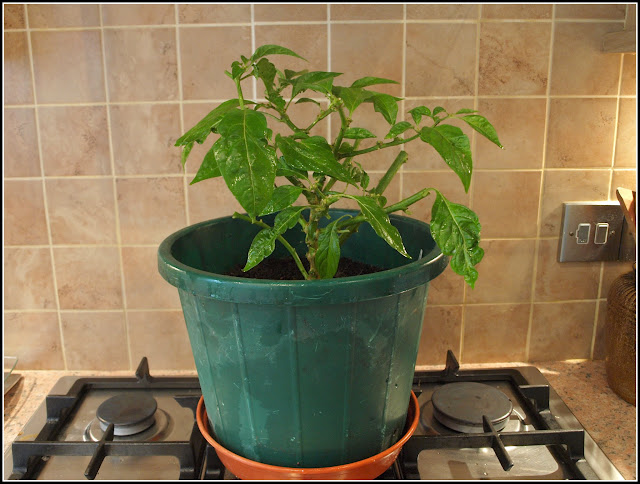Over the last couple of years I have been experimenting with over-Wintering mature chilli plants. If you can keep the plants alive over the Winter they will produce a crop the following year much sooner than new plants grown from seed. This is definitely an attraction when our English Summers are as poor as they have been in recent years!
 |
| Scotch Bonnet Caribbean Antillais |
In the right conditions (i.e. tropical ones!) the chilli is a perennial plant, but in England even if you keep your chillis in a warm room it is far from certain that they will survive the Winter. I keep mine on the windowsill of our spare bedroom, but at night-time the temperature in that room can still be pretty low. Of course if I were prepared to heat the room constantly, just for the benefit of the plants, they would love that, and would be much more likely to survive, but my energy bills would go up a lot so I don't think it would be justifiable! The survival rate of my chilli plants over the last three Winters has been approximately 50%, which I think is acceptable. I will be prepared for some casualties but I will also expect some successes.
I don't pretend to be a guru on this subject, but I'm going to explain the procedure I use, just in case you might want to copy it.
I start with a strong, healthy plant. A weak, sickly one is not worth bothering with. This one is my Scotch Bonnet Caribbean Antillais one. It has produced some attractive and fiery hot fruits this year and it seems like a perfect candidate for the treatment.
If we look closely at the plant, you can see that it has a strong woody main stem, and lots of branches.
Using sharp secateurs, I remove about two thirds of each mature branch, and I cut out completely any immature soft branches coming directly from the main stem. I also remove the majority of the big leaves. I want the plant to more-or-less go to sleep, and if it has too many big leaves it will be too vigorous.
Having done the pruning, I spray the plant very thoroughly with warm water to which I add a tiny drop of liquid hand soap. This is literally to wash the plant, removing any aphids and any fungal spores. I suppose that specialist Horticultural Soap would be best, but I haven't got any! Finally, I give the plant a good drink of water to help it get over the shock of its surgery.
The end result is a very compact plant, like this:
Now it goes onto the windowsill in the spare bedroom, and I hope for the best... During the Winter I will water it sparingly, without feeding it. If it pulls through I will start feeding it when the first signs of new growth appear. At that point I would probably re-pot it too, using fresh compost.
On a related theme: I have been doing a seed-viability test with some of the seeds I saved last year. I put a few seeds in some 4-inch pots, covered with plastic bags, and placed them in the airing-cupboard for a few days to see if anything would germinate. This one was from a packet labelled "Red Habanero 2014". They are definitely viable! I don't think I will be able to keep this little plant over the Winter, but it confirms for me that it will definitely be worth sowing some of those seeds in the Spring.
This is where those seeds came from - I think the variety is "Paper Lantern".
This year's chilli harvest is drawing to a close, but as you can see I'm already planning for next year's!
























































